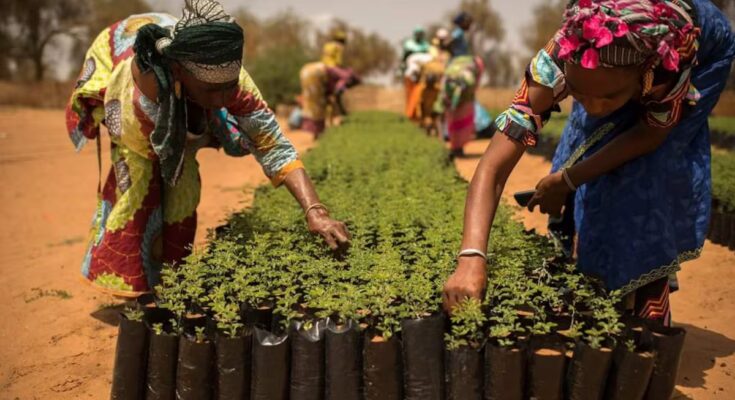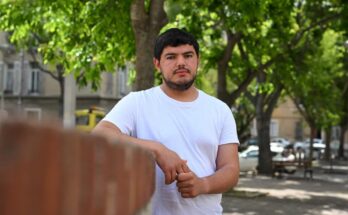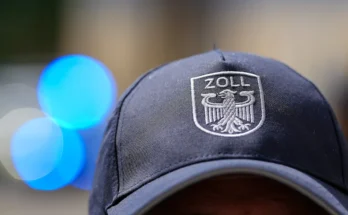Galadima Bulama had already lost count of how many times the strong dusty winds of the Sahara desert had torn the roof off her house and hit the land where she farms. Each time this happened, he, his two wives and seven children sought temporary refuge. Bulama lives in the Nigerian village of Madugumsumi, in Jigawa state, on the border with Niger. In this agricultural village of 7,000 inhabitants, many farmers have abandoned their lands, causing food shortages and loss of income. Every year Nigeria loses approximately 35,000 hectares of land due to the advance of the desert southwards.
Eight years ago Bulama signed up for a solution to protect her home and land. Today he sees the fruits: a wall of 10,000 trees planted six kilometers long protects the village from the wind. They are part of the Great Green Wall, a belt of vegetation 8,000 kilometers long and 15 kilometers wide, which constitutes one of the most ambitious ecological restoration initiatives in Africa.
The African Union launched the project in 2007 in 11 countries – Mauritania, Senegal, Mali, Burkina Faso, Niger, Nigeria, Chad, Sudan, Ethiopia, Eritrea and Djibouti – and promised, by 2030, to restore 100 million hectares of land, create 10 million jobs and capture 250 million tonnes of CO2.
Although the initiative was initially proposed as a plant barrier, the objectives have been broadened. Now, the goal is to reclaim degraded lands, stop desert expansion, improve soil and water conservation, support agricultural and livestock production, create green jobs and help communities adapt to climate change.
“Before this project, the desert occupied the land. Now, when the wind blows, the trees block it and reduce the damage. They have given us hope,” says Bulama. After the investment made by the National Agency for the Great Green Wall, which has been responsible for implementing the initiative in Nigeria since 2015, the villagers continued to plant voluntarily.
About a hundred residents have been hired to protect the trees and prevent them from being cut down. “I make sure no one cuts down the trees,” says village head Musa Balaman proudly. “We remind people how important this project is. Farmers are encouraged to plant more trees and no one is allowed to graze in the area.”
But green has not spread with the same success to other areas of northern Nigeria or to other countries that are part of the Great Wall. The initiative has reached 30% of its execution for the 2020-2030 decade, according to Sakhoudia Thiam, an expert in the research and development office of the Pan-African Great Green Wall Agency, the entity created in 2010 to coordinate the initiative. At COP30, the Agency will try to make the project visible at an event on 18 November in Belém (Brazil) to obtain more resources.
The case of Nigeria and Senegal
In Nigeria executions reach 50%, but there is a lack of funding insecurity – due to terrorist attacks in some areas of the north, such as Zamfara, Katsina and Borno – have slowed down the success of the project.

More than 400 kilometers from Jigawa lies the state of Zamfara. Usman Shehu lives there and, in 2015, began participating in Great Wall programs. But, two years ago, it had to abandon it due to the increase in kidnappings and attacks by armed groups.
“Before planting the trees, the land was bare, without grass or shade,” says Shehu. “There are trees now. The area is more beautiful than before. But insecurity has made work difficult. Officials from the National Great Green Wall Agency no longer come to check the trees because it is too dangerous.” In the Sahel countries affected by conflicts and insecurity, as in Mali and Burkina Faso, work has also been severely affected.
The Nigerian National Agency he states it produced more than 45 million tree seedlings and restored around 12,000 hectares of degraded land between 2015 and 2024. However, experts assure this newspaper that this progress remains small.
For Lawan Cheridean of the Faculty of Management Sciences of the Federal Polytechnic School in Damaturu, it is necessary to verify the progress in the field. “This means visiting actual project sites and beneficiaries to verify claims and ensure results are authentic. We must have clear metrics to measure progress. In Nigeria alone, the target covers more than 100,000 hectares,” he recalls.
In Senegal, where the restoration goal is 817,500 hectares, two researchers monitored progress through satellite imagery and published the results in Land use policy. They found that only two of the 36 plots planted by the project showed “significant ecological trends.” “This may be because new trees are not watered. Although drought-resistant species are planted, many trees die if the rainy season is mild. Our study concluded that, overall, the Great Green Wall had almost no ecological impact in Senegal,” the researchers concluded in a paper recently published in The Conversation. Like other experts consulted by this newspaper, they stressed that the problem is the lack of funding.
Many ambitions, few resources
“The ambitions are enormous, but the means are not enough.” This is the diagnosis made by Sakhoudia Thiam, of the Pan-African Agency of the Great Green Wall, who visited Madrid last June. “We have not reached the necessary speed that allows us to achieve more important results. The financing announcements are not available money,” he said in an interview with EL PAÍS.
In 2021, at the One Planet Summit, an international summit promoting environmental investments, 19 billion dollars (16.3 billion euros) were committed to finance the initiative. Although 16 billion of this sum has already been paid, according to Thiam there are still challenges to face. “Countries lack the capacity to raise the announced funds,” says the expert. The Pan-African Agency also warned, at a meeting in Bamako (Mali), in June, that there is a “large disparity” between participating countries and that “a significant gap exists” with respect to ecological restoration and economic impact objectives.
We have not reached the speed necessary to allow us to achieve more important results. Funding ads are not cash available
Akhoudia Thiam, expert at the research and development office of the Great Green Wall Pan-African Agency
The United Nations Convention to Combat Desertification (UNCCD), which is also involved in the Great Green Wall Accelerator, a mechanism to help coordinate and monitor the initiative’s progress, estimates that to achieve the goals At least 33 billion dollars will be needed. “The gap is huge. Even with the resources we currently have, we do not have the transformative effect we need on the ground,” acknowledges, in a video call with EL PAÍS, Gilles Amadou Ouédraogo, UNCCD project manager for the Accelerator (a mechanism created in 2021 to accelerate and monitor the construction of the Great Wall). For Ouédraogo, investments from the private sector will be needed and not just donations and subsidies, as has happened so far.
The need is so urgent that the question of financing has been put on the table in international contexts. For example, the African Climate Summit declaration in Addis Ababa in September called for resources. At COP30, the Nigerian government also referred to the need for more money.
More green walls
Although construction of the Great Green Wall is not progressing at the pace desired by national and international organizations, the momentum continues and has expanded beyond the 11 countries where it is being built. For example, the Southern African Development Community (SADC) is structuring a Great Green Wall project in the south that will cover 16 countries, from the Democratic Republic of Congo to South Africa. Louise Baker, director of the UNCCD Global Mechanism, explains that SADC has been observing the development of the Sahel Wall for a decade and has learned “valuable lessons” to apply to water, climate infrastructure, economic development and green projects. “South Africa, as president of the G20, is trying to attract foreign investment (for this idea). In 2026, some things will start to take off there,” he anticipates.
For Sakhoudia Thiam, of the Pan-African Agency, this is a sign that the Green Wall is a symbol of hope and continental pride. “The initiative is a hope for integration. It is an African creation that responds to the union of peoples”, he concludes.



